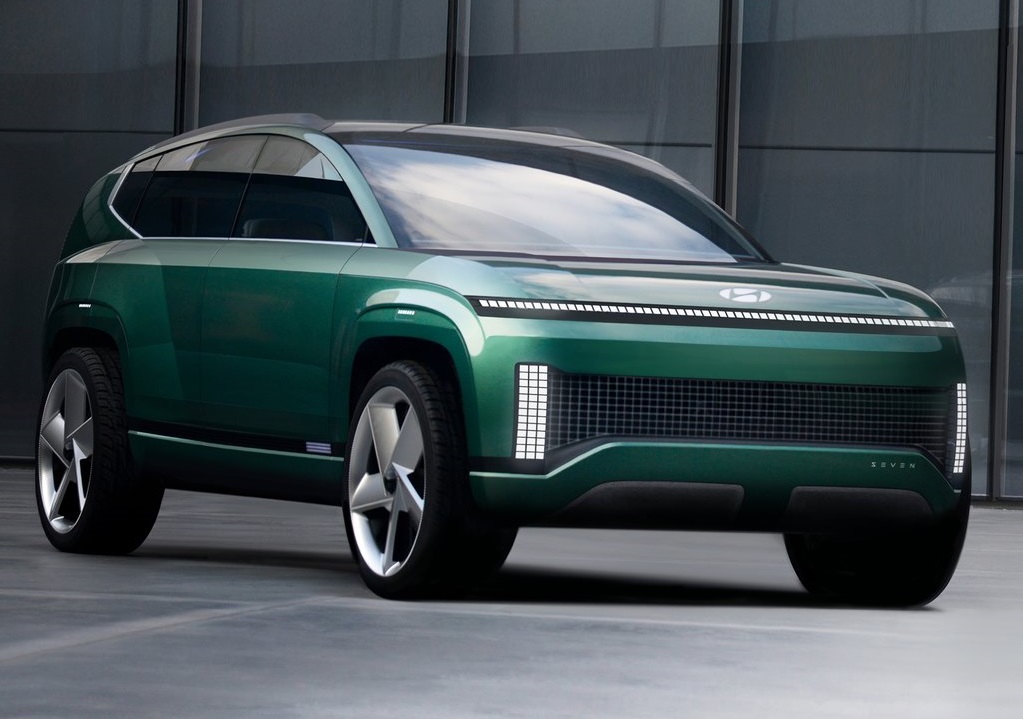Hyundai Motor Company revealed SEVEN, the new sport utility electric vehicle (SUEV) concept at 2021 AutoMobility LA. Following the 45 concept in 2019 and the Prophecy concept in 2020, the SEVEN concept opens a new chapter for the IONIQ brand, Hyundai’s dedicated battery electric vehicle (BEV) showcase. These differentiated design and technology innovations prioritize customer values over industry norms. SEVEN is also a clear representation of Hyundai’s commitment to carbon neutrality by 2045. Every vehicle developed for the IONIQ brand offers a next generation customer experience that seamlessly integrates the most advanced technologies into everyday life settings. SEVEN concept is the perfect example of IONIQ, with its space innovation and hygienic features transforming the vehicle as an innovative living space on wheels. Thanks to its versatile E-GMP platform, SEVEN will be able to provide outstanding driving range and ultra-fast charging capabilities, delivering a driving experience tailored to customer’s needs. In a real-world situation with a 350-kW charger, SEVEN is capable of charging from 10 percent to 80 percent in about 20 minutes. The concept is also engineered to achieve a target range of over 300 miles.

Hyundai Motor has focused on developing vehicles to always ensure a safe and healthy travel experience. SEVEN uses various eco-friendly materials while offering segment-leading hygienic features, such as Hygiene Airflow System and UVC Sterilization. Hyundai applied bio-paint to SEVEN’s exterior and hygienically-recycled and renewable materials throughout the interior. Mineral plaster, bamboo wood and carpet, bio resin and interior paint are based on renewable sources that can reduce pollution from the production process. Extensive use of copper and hygienically treated fabric with proven antibacterial functions ensure all surfaces inside SEVEN remain clean at all times. The Hygiene Airflow System takes inspiration from the sophisticated airflow management of passenger aircrafts. In its vertical mode, air is taken in through built in air intakes in the roof rails from which the air travels from above to below, and extracted through the exterior vent behind the rear wheels. In its horizontal mode, the air flows from the slim dashboard to the rear vents.

SEVEN’s interior design priority lies in the space innovation offering greater freedom for our customers than ever before. SEVEN’s wheelbase reaches 3.2 meters, thanks to its design cue to push the wheels outward to extend the wheelbase as much as possible. The flat floor allows Hyundai Motor to explore an alternative to the traditional row-based seat arrangements, creating a more fluid interior layout. The Pillarless Coach Doors offer a grand entrance to reveal a welcoming interior with a completely new dimension of space. The streamlined roofline, long wheelbase and flat floor that extends to the third row opens new opportunities to furnish the interior like a premium lounge. SEVEN offers flexible space and various in-car appliances that can be personalized for individual passengers. This human-centered approach allows SEVEN to envision a future of mobility and connectivity whilst laying the foundations for future IONIQ models.

SEVEN also embodies Hyundai’s future vision of autonomous mobility. The driver’s seat features a retractable control stick that hides away when not in use. Without the need for the usual driver’s equipment, the ultra slim cockpit and integrated screens create a lounge-like experience. The seat arrangement is unlike traditional SUVs, with swiveling lounge chairs and a curved bench seat. This seat arrangement can be customized depending on driver-controlled or autonomous driving modes. SEVEN has a Universal Island console, specially designed home appliances and a multi-functional Smart Hub graphic user interface. When the Smart Hub and front seats combine with the rear chaise-lounge seating, SEVEN becomes an environment where customers can experience quality time alone or together in the glow of side-door ambient light. In transit, SEVEN’s built-in mini fridge provides chilled refreshment on the go and shoe-care compartments refresh passengers’ footwear. The concept’s vision roof features a panoramic screen that not only displays various content based on passengers’ tastes, but also changes the overall interior atmosphere to guarantee maximum relaxation and pleasure during the journey.

SEVEN concept is built upon Hyundai Motor Group’s Electric-Global Modular Platform (E-GMP), a dedicated BEV architecture. E-GMP’s long wheelbase and flat platform floor enables a completely new class of vehicle that offers new experiences for customers.In support of SEVEN’s powerful road presence are wheels that feature integrated Active Air Flaps, which deploy or retract depending on brake-cooling or low-drag requirements. SEVEN has an aerodynamically pure silhouette instinctively divergent from a typical SUV. The low, leading edge of the hood, a single, streamlined roofline and elongated wheelbase communicate a clear break from traditional SUVs powered by internal combustion engines. The pure volume of SEVEN’s minimal forms contrast with the powerful stance and commanding, rugged presence. Even under darkness of night, SEVEN is easily identified by IONIQ’s signature Parametric Pixel lights that deliver a Welcome Light Sequence on start-up. Parametric Pixels provide a common design thread, linking digital and analog styles, a reminder that its designers considered every aspect of SEVEN’s design, down to a single pixel.















